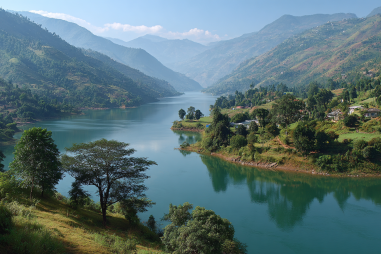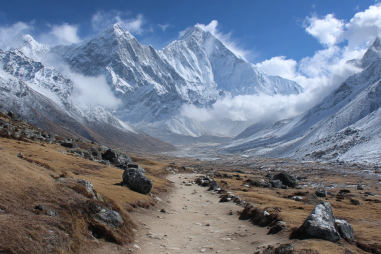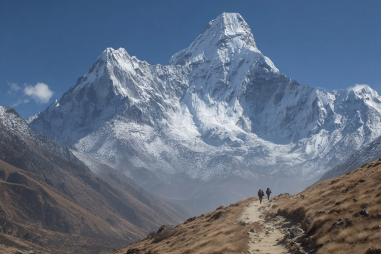Flying into the remote and breathtaking region of the Himalayas is an experience like no other, and Jomsom Airport serves as the perfect gateway to this majestic part of Nepal. Whether you’re a seasoned trekker, a nature enthusiast, or simply someone eager to explore the stunning landscapes of the Annapurna region, understanding the details about Jomsom Airport can help ensure your journey is smooth and enjoyable. This guide offers everything you need to know about flying into Jomsom, covering flight options, schedules, practical tips, and essential safety advice.
Overview of Jomsom Airport
Jomsom Airport (IATA: JMO) is a small domestic airport located in the town of Jomsom, in the Mustang District of Nepal. Situated at an elevation of approximately 2,740 meters (8,990 feet) above sea level, the airport serves as a critical hub connecting the Mustang region to the capital, Kathmandu, and other parts of Nepal. Due to its high altitude and location in a mountainous region, Jomsom Airport is known for its spectacular aerial views and challenging flying conditions.
The airport has a single asphalt runway that measures about 533 meters (1,750 feet), making it suitable for small aircraft such as STOL (Short Takeoff and Landing) planes. Jomsom is often the preferred air route for travelers who wish to avoid long and arduous road journeys through rugged terrain, making flights here a popular choice during the trekking seasons.
Airlines Operating Flights to Jomsom
A few domestic airlines operate regular flights to and from Jomsom Airport, mainly connecting Jomsom with Kathmandu. Some of the primary airlines servicing this route include:
- Tara Air
- Sita Air
- Shree Airlines
- Buddha Air
These airlines typically use smaller fixed-wing aircraft designed for mountain flying, such as the Twin Otter and De Havilland DHC-6 planes, which are well-equipped for short landings and takeoffs on the challenging runway.
Flight Schedules and Seasonal Variations
Flight schedules to Jomsom airport are highly dependent on weather conditions, particularly because the airport lies in a mountainous region prone to sudden weather changes. Generally, flights operate daily during the peak trekking seasons, which are spring (March to May) and autumn (September to November). These months are favored because of more stable weather, clear skies, and pleasant temperatures.
During the low season (winter and monsoon), flights may be less frequent or canceled due to poor visibility, rain, or strong winds. It’s important for travelers to remain flexible and prepare for delays or rescheduling during these months.
Flights usually run early in the morning since the weather tends to be most stable before wind and clouds build up in the afternoon. Most airlines suggest arriving at the airport well ahead of the departure time due to limited facilities and manual check-in procedures.
Tips for Flying in Mountain Regions
Flying into mountainous airports like Jomsom requires extra preparation and awareness due to the unique challenges of high altitude and rapidly changing weather. Here are some handy tips to keep in mind:
- Arrive early: Given the weather-related delays and limited airport facilities, it’s best to arrive early and be mentally prepared for potential waiting times.
- Pack light: Airlines operating to Jomsom have strict weight limits because of aircraft capacity and safety regulations.
- Stay updated on weather: Monitor weather reports and stay in touch with your airline for flight status updates.
- Wear comfortable clothing: Temperatures can vary significantly; layering helps.
- Prepare for bumpy flights: Mountain flying may include turbulence, so stay calm and follow crew instructions.
- Have travel insurance: It’s wise to cover unexpected cancellations or medical emergencies.
Airport Facilities and Services
Jomsom Airport is relatively basic in terms of facilities. It is primarily designed to serve local travelers and trekkers rather than international tourists. Some features include:
- A small terminal building with a waiting area
- Basic check-in counters
- Limited food and beverage options
- Restrooms with basic amenities
There are no advanced medical facilities or luggage handling services, so travelers should be prepared to carry their own bags and attend to personal needs independently. Because of the high altitude, it’s recommended to stay hydrated and avoid overexertion while at the airport.
Transport Options from the Airport to Jomsom Town
The airport is conveniently located within walking distance of Jomsom town, making onward transportation straightforward. Upon arrival, visitors can:
- Walk: It’s a short, easy walk to the town center, ideal for those carrying manageable luggage and eager to stretch their legs.
- Arrange a private taxi or jeep: Available outside the terminal for more comfortable or luggage-heavy transport, especially if continuing onward to places like Kagbeni or Mustang.
- Use local buses or shared jeeps: These are available but infrequent, and schedules may depend on demand.
For most travelers, especially those heading deeper into the Annapurna trekking circuits or Mustang region, it’s advisable to pre-arrange transportation or trekking guides to ensure smooth onward travel.
Weather Considerations Affecting Flights
The mountainous terrain around Jomsom makes weather a major factor in flight operations. Key considerations include:
- Strong winds and turbulence: Because Jomsom is situated in a valley flanked by tall peaks, air currents can be unpredictable.
- Fog and low visibility: Cloud cover can descend quickly, causing delays or cancellations.
- Seasonal rainfall: The monsoon season (June to August) brings heavy rain and thunderstorms, often grounding flights.
- Winter cold and snow: Although snowfall is rare at Jomsom itself, nearby passes may be affected, and cold weather can impact aircraft operations.
Pilots and airlines frequently monitor weather closely to decide if it’s safe to operate flights, so it’s common for schedules to change at short notice. Travelers should remain flexible and patient when flying into this region.
Safety Precautions and Advice
Given the unique challenges of mountain aviation, safety is paramount when flying to Jomsom. Here are some recommended precautions and pieces of advice:
- Choose reputable airlines: Review airline safety records and pilot experience in mountain flying.
- Follow crew instructions: Pay close attention during safety briefings and be prepared for ground handling at a small airport.
- Stay calm during turbulence: Mountain flights can be bumpy; seat belts should always remain fastened during flight.
- Prepare for altitude: Jomsom’s high elevation can affect breathing; if you have respiratory or heart conditions, consult your doctor before flying.
- Confirm bookings and check for updates regularly: Flights may be canceled or delayed due to weather, so verify your itinerary frequently.
Travelers planning to trek or explore the Mustang region should also carry basic first aid supplies and acclimatize properly to avoid altitude sickness.
Planning Your Air Travel to Jomsom
Flying into Jomsom airport can be the highlight of your Himalayan adventure, providing breathtaking views and quick access to one of Nepal’s most spectacular regions. To make your experience as seamless as possible, plan ahead by booking flights early during peak seasons, pack light, and be prepared for potential weather-related disruptions.
Remember that Jomsom Airport is more of a functional gateway than a luxury terminal, so managing your expectations regarding facilities will help you stay comfortable. Staying informed about flight schedules, airline options, and local transport will allow you to make the most of your journey into the heart of the Himalayas.
With a little preparation and flexibility, your flight into Jomsom can open the door to incredible landscapes, rich culture, and unforgettable adventures.







